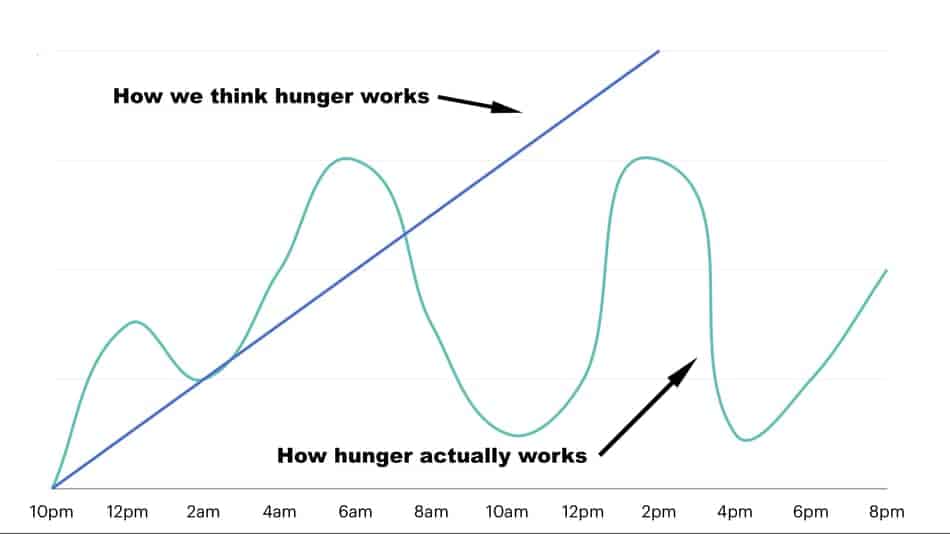I’ve done OMAD for a number of months and I love it. I started with a 16/8 fast, but I find that eating one meal a day works better.
In this article, I pull up the curtain and show you everything I have in my toolbox to make your OMAD journey a success story.
Like any intermittent fasting protocol, OMAD is an extremely effective way to lose weight, but it has to be personalized.

1. Look at the long term
There is no reason why you shouldn’t do one meal a day for the long term. From my experience, the longer I stick to the plan, the easier it got.
“Eating one meal a day (or any form of intermittent fasting) over time leads to lower cravings, better self-awareness, and higher satiety,” says an expert on postprandial metabolism in humans, Emma C. E. Meessen. MD.
“This helps to lose weight and improve metabolic flexibility during exercise via increased fat oxidation, without reducing physical performance,” explains Dr. Meessen.
For me, one meal a day helped me to realize that hunger is not an emergency (see the graph below).

Eating one meal a day ‘forever’ isn’t healthy or fun. It requires skills to build your meals in a way that they contain all essential macro and micronutrients.
Instead, try doing OMAD on certain days (or months) where you do one meal a day, followed by normal eating.
I did OMAD long-term and here are some of the lessons that I’ve learned:
- Hunger is not an emergency
- Physical hunger is different than psychological hunger
I like to think of OMAD as a tool. I don’t treat it like a lifestyle.
2. Be mindful of your hunger signals
When I’m feeling hungry on OMAD I usually do several things to lower my food cravings.
For instance:
- drinking calorie-free beverages
- exercising
- taking MCT oil
- chewing gum
All those methods help me to reduce my hunger pangs and suppress my appetite.
It took me a while to eat one meal a day without feeling hungry. When I was eating 3 meals a day, my body was used to a higher volume of food.
3. Start by doing OMAD every other day
In the beginning, I ate one meal a day every second day. For 3-4 days a week, I eat just one meal. For the rest of the week, I was eating 2-3 meals a day.
I always modified my eating plan based on my schedule.
For instance, on the days when I was busy and swamped with work, I did try to eat less. On the days when I don’t have to rely so heavily on my energy, I did OMAD.
You can also take this extra step further and commit to fasting only on the weekend, and eating as usual during the week.
4. Make it a little harder
You can do OMAD for 5 days a week, as long as you don’t overeat for the remaining 2 days.
Doing OMAD 5 days a week is enough to create a negative energy balance.
To maintain a calorie deficit, for the rest 2 days you should focus on adding more protein-rich foods to your diet.
This is a great option for people who:
- Want to build muscle mass while doing calorie deficit
- Need more calories (energy) on specific days of the week
- Are getting started with OMAD and need more flexibility
In other words, eating one meal a day for 5 days a week will help you maintain lean body mass, and if you’re physically active then it will prevent you from losing muscle.
That is exactly what happened to me when I first started doing OMAD.
5. Take it up a notch
Taking it up a notch I mean eating one meal a day every day for one week.
Ensure you have all the essential nutrients in your meal. When doing one meal a day I always include plenty of protein, vegetables, and fruits.
Plus, I also try to eat slowly and drink enough water. (This usually helps me combat my hunger for the rest of the 23 hours.)
6. Don’t worry about carbs
I always included carbs (e.g., potatoes) that have a high satiety score. This way I was feeling fuller for longer.
I never did Keto with one meal a day. I felt like I need to have a balanced meal to ensure I deliver all micro and macronutrients.
Carbs are full of vitamins, minerals, water, and fiber which is essential when you reduce food volume to just one meal a day. So adding carbs gave me energy but also completes the nutrient profile.
I know it may sound novel because everywhere you look, all you see is the message that carbs are bad. And If you’ve been doing keto for a long time, you’ve probably automatically wired to stay away from carbs.
But you need to understand that having a selective group of carbs with high fiber and high water content can help to increase satiety and lower appetite. Plus, when you have just one meal a day, you want fewer rules, not more.
